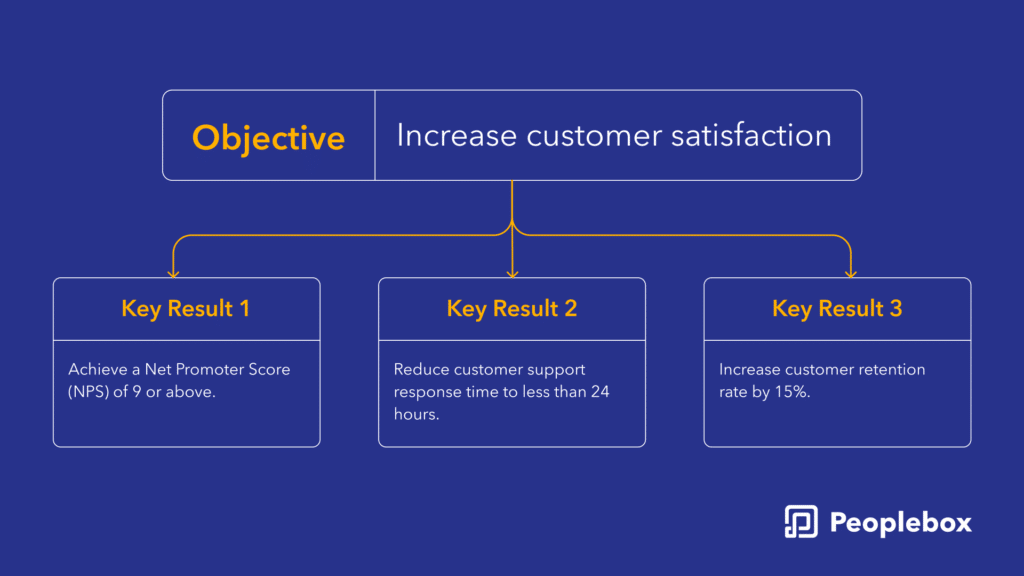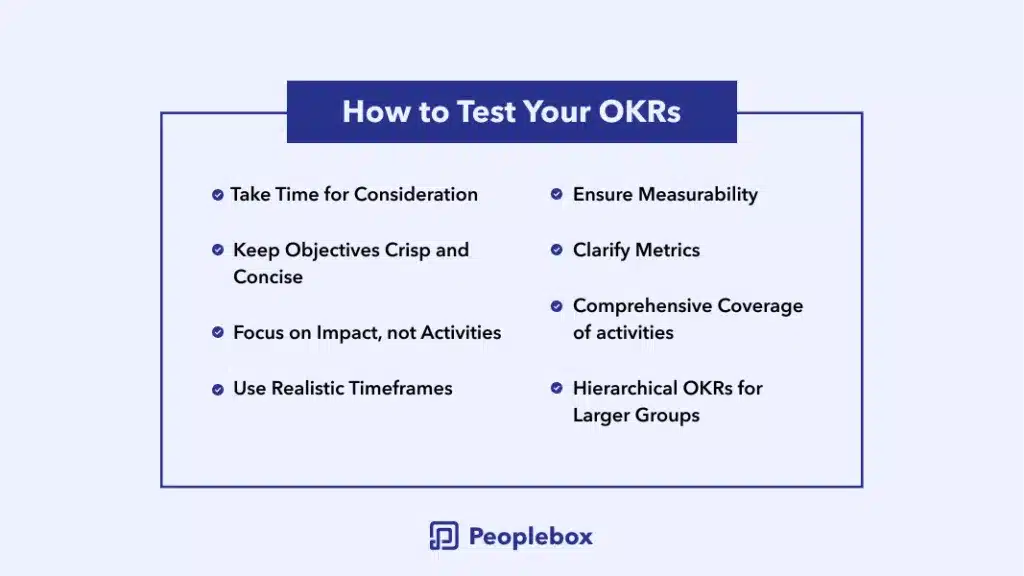In the realm of organizational effectiveness and goal achievement, Google has long been recognized as a trailblazer. Their secret sauce? The powerful OKR (Objectives and Key Results) methodology, which they pioneered and perfected, and converted into an OKR playbook. Designed to align teams, foster innovation, and drive tangible outcomes, Google’s OKR playbook has become a cornerstone for many successful companies seeking to maximize their potential.
In this guide, we will delve into the intricacies of Google’s OKR playbook. Here we will uncover why a goal-setting framework is important, why Google believes in the OKR framework and explore its profound impact on organizations worldwide.
OKRs and Their Importance
At its core, OKR revolves around setting aspirational and moonshot objectives that act as a guiding light for teams. These objectives go beyond mundane tasks and instead inspire individuals to strive for excellence, infusing their work with purpose and direction.
OKR is a goal-setting framework that helps organizations and teams define and track their objectives and the key results they aim to achieve. It comprises of:
1. Objectives: Objectives are clear and inspiring statements that define what is to be achieved. They provide a sense of direction and purpose, guiding teams towards a common goal.
2. Key Results: Key Results are measurable outcomes that indicate progress towards the objective. They are specific, measurable, and time-bound. Key Results provide a way to track and evaluate success.
Consider this simple formula to further simplify OKR:
Objective: What you want to achieve
Key Results: How you will measure progress towards the objective
For example:

What is Google OKR Playbook?
History of OKR at Google
The roots of the OKR framework can be traced back to the 1970s and 1980s when renowned management expert Andy Grove introduced the concept at Intel. Google further popularized OKRs and showcased their immense potential for driving success.
In the early 2000s, as Google was experiencing rapid growth and expansion, the need for a scalable goal-setting methodology became apparent. This led to the adoption of OKRs as a core part of Google’s culture and management approach.
The company’s co-founders, Larry Page and Sergey Brin, embraced OKRs as a way to align the organization, promote transparency, and foster a results-driven mindset.
Why OKR Framework?
Google believes in the concept of OKR—pressing impetus on measurable outcomes that signify progress toward the defined objectives. Here’s why:
- Objectives define what needs to be accomplished and set the direction for teams. They are ambitious, inspirational, and aligned with the organization’s overall mission and strategy. Objectives should challenge teams to stretch beyond their comfort zones and rally everyone towards a shared purpose.
- Key results, on the other hand, provide a quantifiable yardstick for success, allowing teams to track their advancements, and identify areas for improvement. By establishing specific, measurable, and time-bound key results, organizations can translate lofty aspirations into concrete achievements.
- Transparency and visibility: Google’s OKR playbook also embraces transparency as a foundational principle. By openly sharing objectives and key results across the organization, teams gain visibility into the broader strategic landscape, enabling them to align their efforts, identify potential synergies, and leverage collective expertise. This transparent approach cultivates a culture of collaboration, accountability, and shared ownership, where everyone is empowered to contribute to the organization’s overall success.
Key Components of the Playbook
1. Objectives
Objectives are the core building blocks of Google’s OKR playbook. They define what an individual, team, or organization aims to achieve. Objectives are inspiring, ambitious, and aligned with the overall strategy of the organization. There are 2-3 objectives each quarter which define the path of work of the organization.
2. Key Results
Key Results are the measurable outcomes that indicate progress towards the objectives. They are specific, measurable, and time-bound. Key Results define the criteria for success and provide a way to track and evaluate progress. Each objective typically has 2-5 key results that act as milestones or targets to be achieved.
3. Initiatives
Initiatives are the actionable steps and projects undertaken to drive progress towards the OKRs. They represent the specific activities and strategies that teams will pursue to achieve their goals. Initiatives outline the tactical plans and resources required to make the desired outcomes a reality.
4. Grading
Grading is a crucial element of Google’s OKR playbook. It involves regular assessments and evaluations of the results. Teams grade their progress against each key result, typically using a scale like 0-1.0 or 0-100%. Grading provides a quantitative measure of achievement and helps teams reflect on their performance, identify areas for improvement, and iterate on their strategies.
The grading process also allows for effective cascading of OKRs. As OKRs are cascaded throughout the organization, grading helps align individual, team, and organizational goals, ensuring that everyone is working towards the same standards of achievement.
Importance of Using a Proven OKR Framework
Implementing a proven OKR framework, such as Google’s OKR playbook, can have a transformative impact on your organization. By adopting this structured approach to goal setting and achievement, businesses can reap a range of benefits that contribute to their overall success.
1. Improved Goal-Setting: A robust OKR framework provides a structured process for setting clear and meaningful goals. By aligning objectives with the company’s mission and strategy, teams can gain a sense of purpose and direction. This clarity fosters a goal-oriented culture where individuals and teams understand what they are working towards and why.
2. Better Alignment with Company Strategy: OKRs create a cascading effect, aligning the efforts of individuals and teams with the broader organizational goals. This alignment ensures that everyone is moving in the same direction, working towards common objectives.
3. Increased Transparency and Accountability: As mentioned, transparency is the cornerstone of Google’s OKR playbook. By sharing objectives and key results throughout the organization, teams gain visibility into the goals and progress of others. This transparency fosters accountability, as individuals and teams take ownership of their OKRs and their impact on the organization.
4. Enhanced Communication and Collaboration: OKRs serve as a common language that enables effective communication and collaboration. By articulating objectives and key results, teams can support, share knowledge, and leverage collective expertise. This facilitates conversations about progress, and challenges, fostering a culture of open dialogue and collaboration.
5. Improved Performance Tracking and Measurement: The OKR framework provides a clear structure for tracking and measuring progress. They offer specific and measurable outcomes that act as indicators of success. Regular check-ins and grading processes allow teams to monitor their progress, identify areas for improvement, and make data-driven decisions. This enables continuous learning and adaptation, ensuring that efforts are directed towards the most impactful actions.
How to Get Started With Writing OKRs
We’ve divided this OKR writing section into two sections. One will help you get tips for setting objectives, while the other will help you develop results that’ll ensure successful implementation. Let’s read them below.
Tips for Setting Objectives
1. Limit the Number: Select just 3-5 objectives to avoid overextending teams and diluting efforts. A focused approach enables better clarity and progress.
2. Push for New Achievements: Avoid expressions that imply maintaining the status quo. Instead, use phrases that encourage growth and advancement, such as “reach new market segments” or “launch innovative products.”
3. Use Endpoint and State Expressions: Frame objectives with clear endpoints or desired states. For example, “become a market leader in the XYZ industry” or “achieve 95% customer satisfaction rating.”
4. Be Specific and Clear: Use tangible, objective, and unambiguous terms in your objectives. Ensure that progress and completion can be easily observed and measured. Research shows that specific goals lead to higher performance and goal attainment.
Tips for Developing Key Results
1. Set 3 Key Results: Determine having 3 key results per objective to focus efforts on measurable milestones.
2. Directed towards the Objective: Each key result should directly contribute to the achievement of the objective. They should serve as significant milestones that drive progress.
3. Focus on Outcomes, Not Activities: Phrase key results to describe the desired outcomes, not the activities to be performed. Instead of using words like “consult” or “analyze,” emphasize the impact, such as “improve customer satisfaction by 15%.”
4. Ensure Measurability and Evidence: Make sure key results can be measured and that evidence of completion is available, credible, and easily discoverable. This allows for accurate tracking and evaluation of progress.
Must Remember: The Three key facets of OKR Implementation
When implementing OKR there are several important points to keep in mind because they contribute to the overall success and effectiveness of the goal-setting framework. Here are three key points to remember:
- Alignment
Alignment is crucial when implementing OKR. It is essential to align the OKRs of individual teams and departments with the broader organizational goals and strategy. This alignment ensures that everyone is working towards the same overall objectives, promoting synergy and cohesion across the organization. Regularly review and cascade objectives to maintain alignment at all levels of the organization.
- Prioritization
Prioritization is key to effective OKR implementation. With limited resources and time, it’s important to prioritize objectives and key results to focus on the most impactful initiatives. Ensure that the selected objectives are aligned with the organization’s strategic priorities and have the potential to drive significant value. Prioritization helps avoid spreading resources too thin and allows teams to concentrate their efforts on the most critical areas.
- Communication
Effective communication is vital for successful OKR implementation. Clearly communicate the OKRs, and the rationale behind them to ensure everyone understands the desired outcomes and their significance. Regularly communicate progress, updates, and any changes to keep everyone informed and engaged.
Foster an environment where open dialogue and feedback are encouraged, enabling teams to collaborate and support each other in achieving their OKRs.
Developing Team OKRs
Developing team OKRs involves aligning team goals with organizational objectives. This is achieved through collaboration, clear objective setting, and measurable key results.
- Engage team members to gather input and create challenging yet attainable objectives.
- Establish specific, time-bound key results to track progress effectively.
- Align team OKRs with higher-level objectives, communicate transparently, and regularly review and refine them to stay agile and responsive.
- Regular review and alignment with higher-level objectives foster adaptability and transparency, enabling teams to stay on track and drive meaningful impact.
By following this systematic approach, teams can create a powerful framework that drives focus, alignment, and successful goal achievement within the organization.
Avoid OKR-writing Mistakes
Setting effective OKRs is essential for driving focus, alignment, and success within organizations. However, it’s important to be aware of common mistakes that can hinder the effectiveness of OKRs and limit their potential impact.
By understanding and avoiding these mistakes, teams can ensure that their OKRs are meaningful, ambitious, and capable of driving significant progress. Here are some common mistakes to be aware of and tips to avoid them:
1. Miscommunicating Stretch Goal OKRs
When setting stretch goal OKRs, it’s essential to communicate them clearly. Clearly define the ambitious nature of these objectives to prevent misunderstandings or confusion. Ensure that team members understand that stretch goals are designed to push boundaries and inspire innovation. For example, Google sets ambitious stretch goals but does not expect 100% achievement of the goal. It clearly communicates its expectation of achieving a 70% goal.
2. Business-as-Usual OKRs
Avoid setting OKRs that merely reflect routine or ongoing tasks. OKRs should be challenging and focused on achieving significant outcomes. Instead of using phrases like “maintain” or “continue,” strive to set objectives that drive growth, improvement, and measurable impact.
3. Sandbagging
Sandbagging refers to setting easily achievable objectives to guarantee success. This undermines the purpose of OKRs and inhibits progress. Encourage teams to set moonshot objectives that stretch their capabilities, aiming for substantial achievements rather than playing it safe. And as mentioned earlier, the expectation should be to achieve 70% of the stretch goal that brings real value.
4. Low-Value Objectives
Ensure that objectives are meaningful and aligned with the organization’s strategic priorities. Setting objectives that lack value or do not contribute significantly to the overall goals can lead to wasted time and resources. Focus only on objectives that have a high impact and align with the organization’s mission.
5. Insufficient Key Results for Objectives
Each objective should have a set of key results that provide measurable milestones to track progress. Insufficient key results can make it challenging to assess success or progress accurately. Ensure that key results are specific, measurable, and tied directly to the objective, providing clear indicators of achievement.
6. Committed vs. Aspirational Goals
Distinguish between committed goals (which are more predictable and achievable) and aspirational goals (which are more ambitious and uncertain). Both types have their place in OKRs. Balance the portfolio of objectives by including a mix of both committed and aspirational goals to drive growth and innovation while maintaining a realistic approach.
How to Test Your OKRs
Testing OKRs is an important step in ensuring their effectiveness and relevance. Here are some approaches to testing OKRs:

1. Take Time for Consideration
If you wrote your OKRs in a rush within five minutes, they may not be well thought out. Reflect on your objectives and results to ensure they are meaningful and strategic.
2. Keep Objectives Crisp and Concise
If your objective cannot fit on one line, it might lack clarity. Make sure your objectives are concise and easily understandable, allowing for a clear focus and direction.
3. Focus on Impact, not Activities
Avoid using internal terms in your key results. Instead, emphasize the impact of your actions. State the desired outcome and why it matters. For example, instead of saying “Launch a new marketing campaign,” say “Increase customer engagement by 20% through the implementation of a targeted marketing campaign.”
4. Use Realistic Timeframes
Ensure that your key results are time-bound and realistic. If all your key results are set for the last day of the quarter, it may indicate a lack of planning. Distribute key results across the duration of the quarter to demonstrate a well-structured plan.
5. Ensure Measurability
Make sure your key results are measurable and allow for objective evaluation. Avoid vague statements like “improve sign-ups.” Instead, specify measurable targets, such as “increase monthly sign-ups by 50% by June 30.”
6. Clarify Metrics
Avoid ambiguity in your metrics. Clearly define whether you are referring to all-time users or seven-day active users when specifying numbers like “1 million users.”
7. Comprehensive Coverage of activities
Ensure that your OKRs cover all significant activities and efforts of your team. If there are important aspects not addressed by your OKRs, consider adding them to ensure a comprehensive approach.
8. Hierarchical OKRs for Larger Groups
For larger teams, implement hierarchical OKRs. Have high-level objectives for the entire team and more detailed objectives for subteams. Ensure that “horizontal” OKRs, requiring contributions from multiple teams, have supporting results within each subteam.
Conclusion
The Google OKR playbook serves as a comprehensive guide for implementing OKR framework. It emphasizes clear objectives, measurable key results, actionable initiatives, and regular grading to drive focus, alignment, transparency, and accountability.
By adopting this playbook, you can align goals with company strategy, improve communication, foster innovation, and track performance effectively. Successful implementation requires commitment, clear communication, and ongoing refinement.
Regular evaluation and adjustment of OKRs are crucial for staying agile and ensuring objectives remain relevant and impactful.
Embracing this framework can transform your goal-setting practices and drive faster success.







